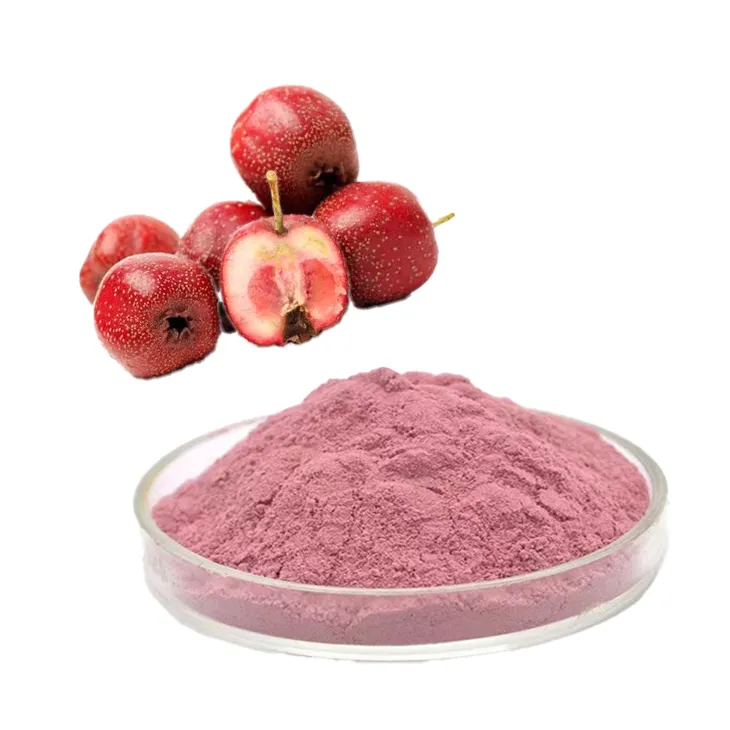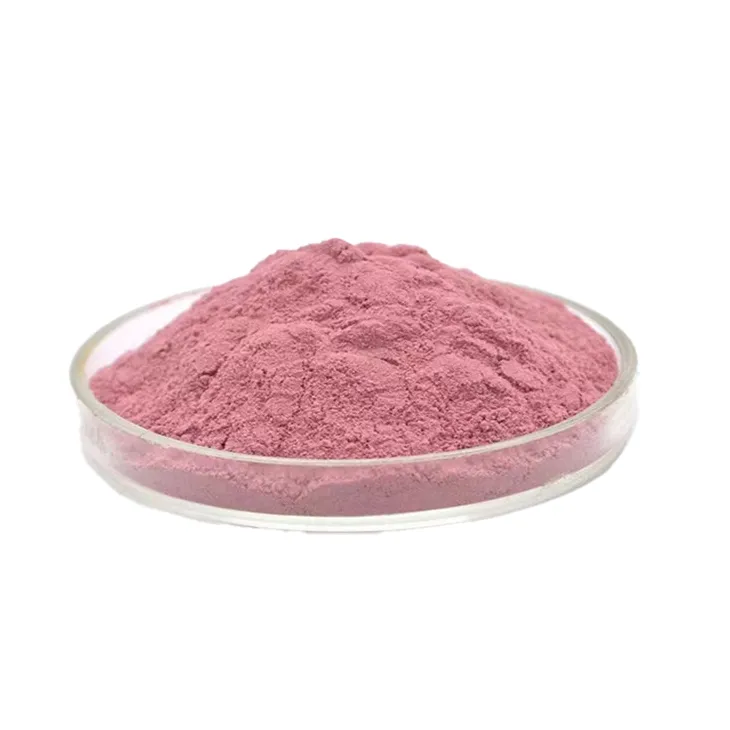- 0086-571-85302990
- sales@greenskybio.com
Components of Hawthorn Powder as Fertilizer and Feed.
2024-11-29

1. Introduction
Hawthorn powder has been increasingly recognized for its valuable applications in both fertilizer and feed industries. Its unique composition makes it a promising candidate for enhancing plant growth and improving animal nutrition. Understanding the components of Hawthorn powder is crucial for maximizing its potential in these two areas.

2. Components in Hawthorn powder for Fertilization
2.1 Organic Matter
Hawthorn powder is rich in organic matter. Organic matter plays a fundamental role in soil fertility. When added to the soil as a fertilizer, it improves soil structure. It helps in creating a more porous soil, which allows for better water infiltration and air circulation. This is vital for plant roots as they need oxygen for respiration. The organic matter in hawthorn powder also acts as a reservoir for nutrients, slowly releasing them over time, thus providing a continuous supply of essential elements for plant growth.
2.2 Macronutrients
- Nitrogen (N): Nitrogen is a key macronutrient for plants. It is an essential component of amino acids, which are the building blocks of proteins. In hawthorn powder, nitrogen is present in various forms. When applied as a fertilizer, it promotes leafy growth in plants. A sufficient supply of nitrogen results in lush, green foliage, which is important for photosynthesis as leaves are the main sites for this process.
- Phosphorus (P): Phosphorus is involved in energy transfer and storage within plants. It is also crucial for root development, flowering, and fruiting. Hawthorn powder contains phosphorus compounds that can be released into the soil. Adequate phosphorus levels from hawthorn powder fertilization can lead to stronger root systems and increased flower and fruit production.
- Potassium (K): Potassium helps in regulating plant physiological processes such as water uptake and transpiration. It also enhances plant resistance to diseases and environmental stresses. The potassium present in hawthorn powder can contribute to overall plant health and vigor, making plants more resilient to adverse conditions.
2.3 Micronutrients
- Iron (Fe): Iron is necessary for chlorophyll synthesis. A lack of iron can lead to chlorosis, a condition where leaves turn yellow due to insufficient chlorophyll. Hawthorn powder can supply iron to the soil, ensuring healthy green leaves and proper photosynthetic activity in plants.
- Zinc (Zn): Zinc is involved in enzyme activation within plants. It plays a role in various metabolic processes, including hormone regulation. Hawthorn powder may contain zinc, which can enhance plant growth and development by promoting the proper functioning of enzymes.
- Manganese (Mn): Manganese is also important for enzyme activation, particularly those involved in photosynthesis and respiration. The presence of manganese in hawthorn powder can contribute to efficient energy production and utilization in plants.

3. Components in Hawthorn Powder for Feed
3.1 Nutritional Components
- Proteins: Hawthorn powder contains a certain amount of protein. Proteins are essential for animal growth, repair, and maintenance of body tissues. In feed, the protein from hawthorn powder can supplement the dietary requirements of animals, especially for non - ruminant animals that have higher protein requirements.
- Carbohydrates: Carbohydrates in hawthorn powder provide energy for animals. They can be broken down into glucose, which is used by cells for various metabolic functions. The carbohydrates present in hawthorn powder can be a valuable energy source, especially for animals with high energy demands such as working animals or growing animals.
- Fats: Although the fat content in hawthorn powder may not be as high as in some other feed ingredients, it still contributes to the overall energy density of the feed. Fats are also important for the absorption of fat - soluble vitamins in animals.
3.2 Bioactive Compounds
- Flavonoids: Hawthorn powder is rich in flavonoids. These bioactive compounds have antioxidant properties. In animal feed, flavonoids can help in reducing oxidative stress in animals. Oxidative stress can lead to various health problems in animals, such as reduced immune function and decreased productivity. By reducing oxidative stress, flavonoids in hawthorn powder can contribute to improved animal health and performance.
- Polyphenols: Polyphenols in hawthorn powder also have antioxidant and anti - inflammatory properties. They can help in maintaining the gut health of animals. A healthy gut is crucial for proper digestion and absorption of nutrients. The polyphenols in hawthorn powder can also play a role in modulating the gut microbiota, which can further impact animal health.
3.3 Vitamins
- Vitamin C: Hawthorn powder contains vitamin C. Vitamin C is an antioxidant and is also involved in various physiological processes in animals. It can help in improving the immune system of animals, making them more resistant to diseases.
- Vitamin E: Vitamin E is another important antioxidant vitamin present in hawthorn powder. It helps in protecting cell membranes from oxidative damage. In feed, vitamin E from hawthorn powder can contribute to the overall antioxidant status of animals, enhancing their health and productivity.

4. The Role of Hawthorn Powder in Soil and Plant Health
The components of hawthorn powder work together to improve soil and plant health. The organic matter and nutrients in hawthorn powder enhance soil fertility, which in turn promotes better plant growth. The micronutrients in hawthorn powder address specific plant needs, such as chlorophyll synthesis and enzyme activation. By improving soil structure and nutrient availability, hawthorn powder can help plants to better withstand environmental stresses, such as drought and disease.

5. The Impact of Hawthorn Powder on Animal Nutrition and Health
- In terms of animal nutrition, the components of hawthorn powder provide a balanced source of nutrients. The proteins, carbohydrates, and fats supply energy and building blocks for animal growth and maintenance. The bioactive compounds and vitamins contribute to animal health by reducing oxidative stress, modulating the gut microbiota, and enhancing the immune system.
- For example, in poultry farming, the addition of hawthorn powder to feed has been shown to improve egg quality. The antioxidants in hawthorn powder can protect the eggs from oxidative damage, resulting in better - quality eggs with higher nutritional value.
- In livestock farming, hawthorn powder can improve meat quality. The bioactive compounds can influence the fat deposition and muscle development in animals, leading to more tender and healthier meat.
6. Processing and Extraction of Components from Hawthorn Powder
- To effectively utilize the components of hawthorn powder in fertilizer and feed, proper processing and extraction methods are required. For fertilizer applications, the hawthorn powder may need to be composted to break down the organic matter further and release nutrients more effectively.
- In feed production, extraction techniques may be used to isolate specific bioactive compounds or to concentrate certain nutrients. However, it is important to ensure that these processing methods do not destroy the beneficial components of hawthorn powder.
7. Conclusion
Hawthorn powder contains a diverse range of components that are valuable for both fertilizer and feed applications. Its nutrients, bioactive compounds, and organic matter play important roles in improving soil fertility, plant growth, animal nutrition, and health. Understanding and harnessing these components can lead to more sustainable and effective use of hawthorn powder in agriculture and animal husbandry.
FAQ:
What are the main nutrients in hawthorn powder for feed?
Hawthorn powder for feed may contain various nutrients. It often has a certain amount of vitamins such as vitamin C, which can enhance the antioxidant capacity of animals. It also may include some minerals like potassium, which is important for the normal physiological function of animals. Additionally, there are carbohydrates and fibers in it that can help with digestion.
How does hawthorn powder contribute to fertilization?
Hawthorn powder can contribute to fertilization in multiple ways. It may contain elements like nitrogen, phosphorus, and potassium in some forms. Nitrogen is crucial for plant growth as it is a major component of proteins. Phosphorus is involved in energy transfer and cell division in plants. Potassium helps in regulating plant water balance and improving stress tolerance.
Are there any specific organic compounds in hawthorn powder for fertilizer?
Yes, there are likely some specific organic compounds. For example, it may contain organic acids that can help in soil acidification to a certain extent, making some nutrients more available for plants. There may also be phenolic compounds which can have an impact on soil microbial activity, influencing nutrient cycling.
What makes hawthorn powder a good component in feed?
Hawthorn powder is a good component in feed because it has several beneficial properties. Its fiber content can improve the intestinal environment of animals, promoting better digestion and absorption. The presence of certain bioactive substances may also enhance the immune system of animals, reducing the incidence of diseases.
How should hawthorn powder be used in fertilization?
When using hawthorn powder in fertilization, it can be composted first. Composting helps to break down the complex substances in hawthorn powder into more available forms for plants. It can then be applied to the soil around plants, either by mixing it into the topsoil or using it as a side - dressing. The amount of application should be adjusted according to the type of plants and the soil condition.
Related literature
- The Nutritional Composition and Utilization of Hawthorn in Animal Feed"
- "Hawthorn - Derived Organic Matter in Soil Fertilization: A Comprehensive Study"
- "Components of Hawthorn and Their Roles in Agricultural Applications"
- ▶ Hesperidin
- ▶ citrus bioflavonoids
- ▶ plant extract
- ▶ lycopene
- ▶ Diosmin
- ▶ Grape seed extract
- ▶ Sea buckthorn Juice Powder
- ▶ Beetroot powder
- ▶ Hops Extract
- ▶ Artichoke Extract
- ▶ Reishi mushroom extract
- ▶ Astaxanthin
- ▶ Green Tea Extract
- ▶ Curcumin Extract
- ▶ Horse Chestnut Extract
- ▶ Other Problems
- ▶ Boswellia Serrata Extract
- ▶ Resveratrol Extract
- ▶ Marigold Extract
- ▶ Grape Leaf Extract
- ▶ blog3
- ▶ blog4
-
Nature's Bounty Lily Extract.
2024-11-29
-
Organic non - transgenic soybean extract.
2024-11-29
-
Chinese Avocado Extract Powder Suppliers.
2024-11-29
-
Baicalin
2024-11-29
-
Kelp Extract Powder
2024-11-29
-
Genistein
2024-11-29
-
Cassia Seed Extract
2024-11-29
-
Red Wine Extract
2024-11-29
-
Aguaje Extract
2024-11-29
-
Acerola Juice Powder
2024-11-29
-
White Willow Bark Extract
2024-11-29
-
Hawthorn Extract
2024-11-29
-
Mulberry Extract
2024-11-29





















